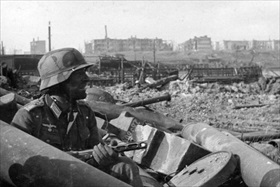CATACLYSMIC STRUGGLE CONTINUES AT STALINGRAD
Stalingrad, Soviet Union · November 1, 1942
By one German count, over five million Red Army soldiers had been taken prisoner since Adolf Hitler unleashed Operation Barbarossa, the invasion of the Soviet Union begun 16 months earlier. As for the number of Soviet service personnel killed and disabled, there was only a rough estimate, but clearly the Red Army had suffered near incomprehensible losses. Still, from the point of view of the German High Command, the Soviets were not defeated and were somehow continuing to resist. Indeed, on this date in 1942, five Soviet armies stood fixed in deep winter snow and ice between Stalingrad (present-day Volgograd), an industrial city that stretched 16 miles along the west bank of the Volga River, and two German armies, the Sixth and Fourth Panzer. The Wehrmacht had overcome the previous winter’s crisis when it failed to take Moscow, the Soviet capital, and now the German armed forces on land and in the skies seemed ready again to defeat and annihilate dozens of Soviet divisions. After their first armored groups had reached Stalingrad’s suburbs at the end of June, the Germans appeared on the brink of capturing their first major Soviet city, which Soviet dictator Joseph Stalin had vowed to defend to the last man. Hitler appeared to be mesmerized by the city that bore the name of his rival. Departing from the policy of Blitzkrieg, Hitler committed his armies to one of attrition. The decision proved to be disastrous for Gen. Friedrich Paulus’ Sixth Army and for Germany itself, in part because the German armed forces, for the second time in two years, were poorly prepared for a winter campaign. On November 19, 1942, the Red Army launched Operation Uranus, part of the ongoing Battle of Stalingrad (September 14, 1942 to February 2, 1943). The next day a second Soviet offensive kicked off south of Stalingrad, and by November 23 Soviet armies closed the ring around the city. German strength inside the ring was about 210,000. In the 11 weeks following this double envelopment, 105,000 surrendered; 35,000 escaped by air; 60,000 died, committed suicide, or were unable to surrender when the end came; and roughly 10,000 men remained to fight on until exterminated (end of February). After Stalingrad the strategic advantage on the Eastern Front shifted to the Soviets, never to change.
[amazon_carousel widget_type=”ASINList” width=”600″ height=”200″ title=”Recommended Reading” market_place=”US” shuffle_products=”False” show_border=”False” asin=”097176509X,0140284583,0700616306,1844159345,0811710890,0300078129,0700616640,1783462477,0307275337,1848327668″ /]
Battle for Stalingrad, September 14, 1942 to February 2, 1943
 |  |
Left: A massive German strategic bombing raid on August 23, 1942, caused a firestorm, killing thousands of Stalingrad residents and turning the city into a vast landscape of rubble and burned-out ruins.
![]()
Right: Carrying a Soviet submachine gun, a German soldier seeks cover among the ruins of an industrial area in Stalingrad.
 |  |
Left: A group of Soviets prepares to ward off a German assault in Stalingrad’s suburbs.
![]()
Right: Soviet soldiers crawl in the rubble of the Red October Steel Factory.
 |  |
Left: A Red Army soldier marches a German soldier into captivity. A handful of captured senior German officers was taken to Moscow and used for propaganda purposes, and some of them joined the National Committee for a Free Germany (NKFD), a German anti-Nazi organization that operated in the Soviet Union during the war. Some higher-ups, among them Paulus, whom Hitler had made Field Marshal hours before the German surrender, joined the NKFD and signed anti-Hitler statements that were broadcast to German troops. Paulus testified for the prosecution during the postwar Nuremberg Trials. He remained in the Soviet Union until 1952, then moved to Dresden in Communist East Germany, where he died in 1957, exactly 14 years after surrendering the German Sixth Army.
![]()
Right: German troops as prisoners of war, 1943. In the background is the heavily fought-over Stalingrad grain elevator. Out of the nearly 110,000 German prisoners captured in Stalingrad, only about 6,000 ever returned. Already weakened by disease, starvation, and lack of medical care during their encirclement, they were sent on death marches (75,000 died within 3 months of capture) to POW camps and later to labor camps all over the Soviet Union. Some 35,000 were eventually sent on transports, of which 17,000 did not survive. Most POWs died of wounds, disease (particularly typhus), cold, overwork, mistreatment, and malnutrition.
Stalingrad: Death of a City
![]()

 History buffs, there is good news! The Daily Chronicles of World War II is now available as an ebook for $4.99 on Amazon.com. Containing a year’s worth of dated entries from this website, the ebook brings the story of this tumultuous era to life in a compelling, authoritative, and succinct manner. Featuring inventive navigation aids, the ebook enables readers to instantly move forward or backward by month and date to different dated entries. Simple and elegant! Click
History buffs, there is good news! The Daily Chronicles of World War II is now available as an ebook for $4.99 on Amazon.com. Containing a year’s worth of dated entries from this website, the ebook brings the story of this tumultuous era to life in a compelling, authoritative, and succinct manner. Featuring inventive navigation aids, the ebook enables readers to instantly move forward or backward by month and date to different dated entries. Simple and elegant! Click 











